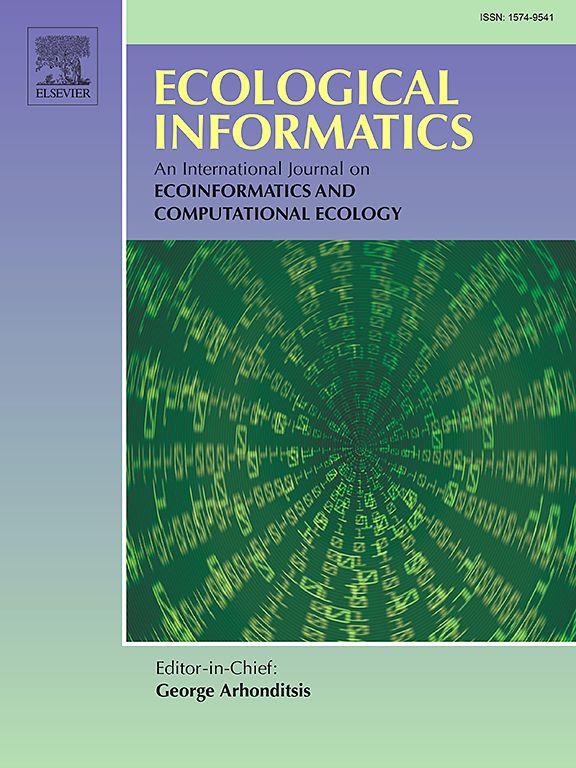结合同位素生态位指标和肠道菌群组合揭示亚热带河流鱼类的共存机制
IF 5.8
2区 环境科学与生态学
Q1 ECOLOGY
引用次数: 0
摘要
了解种间生态位重叠是评价同域物种间资源分配和竞争相互作用的基础。微生物共生体促进了对新的生态位的快速适应,极大地增强了宿主的进化适应性和生态成功。然而,宿主-微生物共生在亚热带河流生态系统中调节鱼类共存模式的机制仍不完全清楚。本研究采用稳定碳(δ13C)和氮(δ15N)同位素分析,定量分析了沅江生态系统7种同域鱼类的营养生态位宽度和重叠度,并对肠道微生物群落进行了高通量测序。结果表明,宿主系统发育特异性主要反映了宿主系统发育保守性介导的确定性选择过程(宿主过滤)的相似性。综合β-多样性分析一致地证实了多种群落指标的系统共生模式。此外,包括扩散限制和漂移在内的随机过程也在塑造特定宿主个体肠道微生物群落的确切组成方面发挥了重要作用。此外,我们的研究结果表明,鱼类宿主营养生态位分化是通过减少资源竞争来促进种间共存的重要适应机制。重要的是,我们发现肠道微生物群落结构的相似性与其营养生态位的重叠程度密切相关,表明宿主营养生态位与其共生微生物群之间的功能趋同。这些微生物适应促进了不同营养来源的营养优化,调解了种间资源分配,并扩大了鱼类群落内的生态机会。我们的综合分析确定宿主-微生物共生是一种进化创新。通过这一机制,亚热带河流生态系统的生态位扩展和竞争共存得以加强。本文章由计算机程序翻译,如有差异,请以英文原文为准。
Integrating isotopic niche metrics and gut microbiota assembly reveals coexistence mechanisms in subtropical riverine fish
Understanding interspecific niche overlap is fundamental for evaluating resource partitioning and competitive interactions among sympatric species. Microbial symbiont facilitates rapid adaptation to novel ecological niches, substantially augmenting host evolutionary fitness and ecological success. Nevertheless, the mechanisms through which host-microbe symbiosis mediates fish coexistence patterns in subtropical riverine ecosystems remain incompletely understood. This investigation employed stable carbon (δ13C) and nitrogen (δ15N) isotope analysis to quantify trophic niche width and overlap among seven sympatric fish species in the Yuanjiang River ecosystem, complemented by high-throughput sequencing of gut microbial communities. Our results showed that host phylogenetic specificity primarily reflected the similarity in deterministic selection processes (host filtering) mediated by host phylogenetic conservatism. Comprehensive β-diversity analyses consistently confirmed phylosymbiosis patterns across multiple community metrics. Moreover, stochastic processes, including dispersal limitation and drift, also played an important role in shaping the exact composition of gut microbial communities within specific host individuals. Furthermore, our findings indicated fish host trophic niche differentiation emerges as an essential adaptive mechanism facilitating interspecific coexistence by minimizing resource competition. Crucially, we identified the similarity of the intestinal microbial community structure is closely related to the degree of overlap of its nutritional ecological niche, indicating functional convergence between host trophic niches and their symbiotic microbiomes.These microbial adaptations facilitate nutritional optimization from varied trophic sources, mediate interspecific resource partitioning, and expand ecological opportunities within the fish community. Our integrative analysis identifies host-microbiome symbiosis as an evolutionary innovation. Through this mechanism, niche expansion and competitive coexistence are enhanced in subtropical river ecosystems.
求助全文
通过发布文献求助,成功后即可免费获取论文全文。
去求助
来源期刊

Ecological Informatics
环境科学-生态学
CiteScore
8.30
自引率
11.80%
发文量
346
审稿时长
46 days
期刊介绍:
The journal Ecological Informatics is devoted to the publication of high quality, peer-reviewed articles on all aspects of computational ecology, data science and biogeography. The scope of the journal takes into account the data-intensive nature of ecology, the growing capacity of information technology to access, harness and leverage complex data as well as the critical need for informing sustainable management in view of global environmental and climate change.
The nature of the journal is interdisciplinary at the crossover between ecology and informatics. It focuses on novel concepts and techniques for image- and genome-based monitoring and interpretation, sensor- and multimedia-based data acquisition, internet-based data archiving and sharing, data assimilation, modelling and prediction of ecological data.
 求助内容:
求助内容: 应助结果提醒方式:
应助结果提醒方式:


